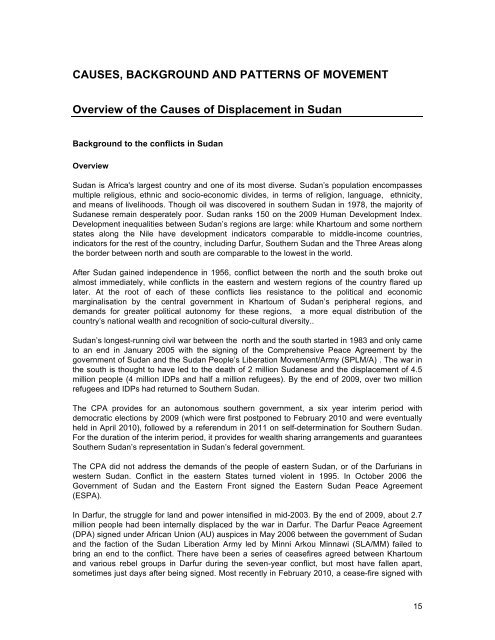SUDAN: Durable solutions elusive as southern IDPs return and ...
SUDAN: Durable solutions elusive as southern IDPs return and ...
SUDAN: Durable solutions elusive as southern IDPs return and ...
Create successful ePaper yourself
Turn your PDF publications into a flip-book with our unique Google optimized e-Paper software.
CAUSES, BACKGROUND AND PATTERNS OF MOVEMENT<br />
Overview of the Causes of Displacement in Sudan<br />
Background to the conflicts in Sudan<br />
Overview<br />
Sudan is Africa's largest country <strong>and</strong> one of its most diverse. Sudan’s population encomp<strong>as</strong>ses<br />
multiple religious, ethnic <strong>and</strong> socio-economic divides, in terms of religion, language, ethnicity,<br />
<strong>and</strong> means of livelihoods. Though oil w<strong>as</strong> discovered in <strong>southern</strong> Sudan in 1978, the majority of<br />
Sudanese remain desperately poor. Sudan ranks 150 on the 2009 Human Development Index.<br />
Development inequalities between Sudan’s regions are large: while Khartoum <strong>and</strong> some northern<br />
states along the Nile have development indicators comparable to middle-income countries,<br />
indicators for the rest of the country, including Darfur, Southern Sudan <strong>and</strong> the Three Are<strong>as</strong> along<br />
the border between north <strong>and</strong> south are comparable to the lowest in the world.<br />
After Sudan gained independence in 1956, conflict between the north <strong>and</strong> the south broke out<br />
almost immediately, while conflicts in the e<strong>as</strong>tern <strong>and</strong> western regions of the country flared up<br />
later. At the root of each of these conflicts lies resistance to the political <strong>and</strong> economic<br />
marginalisation by the central government in Khartoum of Sudan’s peripheral regions, <strong>and</strong><br />
dem<strong>and</strong>s for greater political autonomy for these regions, a more equal distribution of the<br />
country’s national wealth <strong>and</strong> recognition of socio-cultural diversity..<br />
Sudan’s longest-running civil war between the north <strong>and</strong> the south started in 1983 <strong>and</strong> only came<br />
to an end in January 2005 with the signing of the Comprehensive Peace Agreement by the<br />
government of Sudan <strong>and</strong> the Sudan People’s Liberation Movement/Army (SPLM/A) . The war in<br />
the south is thought to have led to the death of 2 million Sudanese <strong>and</strong> the displacement of 4.5<br />
million people (4 million <strong>IDPs</strong> <strong>and</strong> half a million refugees). By the end of 2009, over two million<br />
refugees <strong>and</strong> <strong>IDPs</strong> had <strong>return</strong>ed to Southern Sudan.<br />
The CPA provides for an autonomous <strong>southern</strong> government, a six year interim period with<br />
democratic elections by 2009 (which were first postponed to February 2010 <strong>and</strong> were eventually<br />
held in April 2010), followed by a referendum in 2011 on self-determination for Southern Sudan.<br />
For the duration of the interim period, it provides for wealth sharing arrangements <strong>and</strong> guarantees<br />
Southern Sudan’s representation in Sudan’s federal government.<br />
The CPA did not address the dem<strong>and</strong>s of the people of e<strong>as</strong>tern Sudan, or of the Darfurians in<br />
western Sudan. Conflict in the e<strong>as</strong>tern States turned violent in 1995. In October 2006 the<br />
Government of Sudan <strong>and</strong> the E<strong>as</strong>tern Front signed the E<strong>as</strong>tern Sudan Peace Agreement<br />
(ESPA).<br />
In Darfur, the struggle for l<strong>and</strong> <strong>and</strong> power intensified in mid-2003. By the end of 2009, about 2.7<br />
million people had been internally displaced by the war in Darfur. The Darfur Peace Agreement<br />
(DPA) signed under African Union (AU) auspices in May 2006 between the government of Sudan<br />
<strong>and</strong> the faction of the Sudan Liberation Army led by Minni Arkou Minnawi (SLA/MM) failed to<br />
bring an end to the conflict. There have been a series of ce<strong>as</strong>efires agreed between Khartoum<br />
<strong>and</strong> various rebel groups in Darfur during the seven-year conflict, but most have fallen apart,<br />
sometimes just days after being signed. Most recently in February 2010, a ce<strong>as</strong>e-fire signed with<br />
15
















